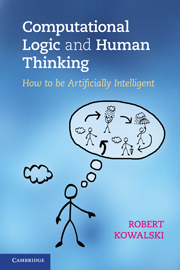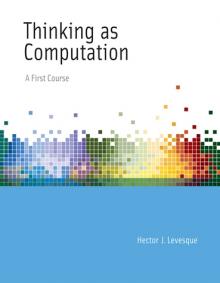Philosophy, Computing, and AI
PHI 319. Syllabus. Welcome to the Course!
Course Description
Instructor: Thomas A. Blackson
A prior course in symbolic logic (PHI 333 or equivalent) is helpful but not necessary to do well in this course.
PHI 319 satisfies QTRS (Quantitative Reasoning) for General Studies Gold
and CS (Computer/Statistics/Quantitative Applications) for General Studies Maroon.
World Logic Day
"Logic is ever-present: when you use AI software, when you turn on your computer, when
you develop an argument. Logic is a contemporary universal. Yet despite being surrounded
by logic, we remain quite unaware of its ubiquity. We often apply logic without knowing
that we are doing so. Thus to draw attention to the importance of logic in the development
of knowledge, UNESCO has proclaimed 14 January World Logic Day."—
Message from
Audrey Azoulay,
Director General of UNESCO, on the
occasion of World Logic Day, 14 January 2021.
Some Online Resources:
Peter Ludlow
About that Nobel Prize in Physics…
Artificial Intelligence. A Modern Approach, 3rd edition
Stuart J. Russell and Peter Norvig
Artificial Intelligence
(Stanford Encyclopedia of Philosophy)
Logic and Artificial Intelligence
(Stanford Encyclopedia of Philosophy)
Non-monotonic Logic
(Stanford Encyclopedia of Philosophy)
Stanford University Symbolic Systems Program
Allen Institute for Artificial Intelligence
The Logic Theorist (Wikipedia)
Eliza, Computer Therapist
Logic Programming (Wikipedia)
Logic Programming (Robert Kowalski)
The Prolog Education Group
8A: Logic Programming, Part 1 (Abelson and Sussman)
8B: Logic Programming, Part 2 (Abelson and Sussman)
Formal Semantics, Lecture 2 (Barbara Partee)
SWI Prolog
Learn Prolog Now!
Robert Brandom
How Analytic Philosophy has Failed Cognitive Science
Noam Chomsky
On Where Artificial Intelligence Went Wrong
Peter Norvig
On Chomsky and the Two Cultures of Statistical Learning
Neural Networks and Deep Learning
GPT-2 and the Nature of Intelligence, Gary Marcus
GPT-3 and General Intelligence, David Chalmers
Eliza, Computer Therapist
We ty to understand and build a
model of the intelligence of a rational agent. A
rational agent has goals and beliefs. Based on its
beliefs, it takes actions in
an attempt to satisfy its goals.
This syllabus and the accompanying lecture notes are in the Tufte CSS style. The center column functions as a page in a book. The right column contains margin notes. Links are underlined, match the text in color, and do not change color on mouseover or when clicked.
More Detailed Course Description
We are trying to understand intelligence in the context of an observation-thought-decision-action cycle that characterizes a rational agent. Rational agents have beliefs and goals. We represent the propositional content of these states as symbolic structures. For some of the thinking in rational agents involving beliefs and goals, we assume this thinking is computational. To model it, we use some of the computational methods in logic programming.
We use some of the methods of logic programming, but this is not a course in computer science. We use these methods because they have their basis in techniques of logic from philosophy, because they provide an understandable first attempt to model of the intelligence of a rational agent, and because they allow us to see important unsolved problems.
The course title has AI in it, but this is not a course in large language models and the artificial neural networks that constitute what some mean when they say AI. We do not try to understand how these techniques represent the intelligence of a rational agent.
This course does not focus on ethical issues involving AI and society. Our interest is in the intelligence of rational agents. Thinking about what one should do is part of this intelligence, but it is only one among the many thought processes in which rational agents engage.
Course Letter Grade
The letter grade is a function of the points on 7 writing assignments and 7 discussion posts. Each writing assignment is worth 10 points. Each discussion post is worth 4 points. The assignments and discussion posts sum to 98 points. 2 points are for reading the syllabus and introducing yourself. There is no extra credit, and late work is not accepted without good reason. I accept more reasons as good reasons if you contact me before the due date.
The point total for the course determines the letter grade: A+ (100-97), A (96-94), A- (93-90), B+ (89-87), B (86-84), B- (83-80), C+ (79-77), C (76-70), D (69-60), E (59-0).
I am happy to work with students on independent projects and Honors Enrichment Contracts.
Course Textbooks
Here are links to the textbooks for the course:

 Computational Logic and Human Thinking: How to
be Artificially Intelligent, Robert Kowalski (Cambridge University Press,
2011).
Computational Logic and Human Thinking: How to
be Artificially Intelligent, Robert Kowalski (Cambridge University Press,
2011).
Thinking as Computation: A
First Course, Hector Levesque (MIT Press, 2012).
The authors have also made some of their teaching materials available. Levesque has slides to accompany his Thinking as Computation. Kowalski has slides to accompany two courses (a shorter and a longer course) based on material he later incorporated into his Computational Logic and Human Thinking. He also has video lectures for his book he recorded at the 22nd International Joint Conference on Artificial Intelligence (IJCAI).
These slides and videos can be helpful but are not necessary for this course.
Course Lecture Notes and Videos
I highlight the most important points in the course in the lecture notes. These points constitute the material on which you will be graded in your discussion posts and assignments.
The lecture notes are generally more straightforward to understand than the books. In addition to the lecture notes, I made a couple of videos for some of the more difficult material.
It is not necessary to understand every detail. To do well in this course, you need understand enough to write a thoughtful discussion post and to answer the questions in the assignments (which are linked through this syllabus). A good strategy is to read the assignment for the module first. Once you know the question or questions you need to answer, read the lecture notes. After you have read the lecture notes, read the relevant sections in the books.
Course Modules
Module 1:
Lecture:
Thinking is
Computation
Introduction to the Logic Programming/Agent Model.
Video:
Backward Chaining
Reading:
• Computational Logic and Human Thinking.
Introduction (14-21), Chapter 1 (22-37)
• Thinking as Computation. Chapter 1 (1-5, 11-21)
Lecture:
Logic and Logic Programming
The Technical Background and Foundations of Logic Programming.
(Not all of this material is required for the course.)
Video:
Backward Chaining Searches for a Proof
Reading:
• Computational Logic and Human Thinking. Appendix A1-A3 (251-283), A5 (290-300)
• Thinking as Computation. Chapter 2 (23-39)
Assignment #1
You are free to talk about the assignment and post questions.
Module 2:
Lecture:
Prolog ("PROgrammation en LOGique")
A Computer Programming Language that Incorporates Principles of Logic Programming.
Video:
Using Prolog Online
Reading:
• Thinking as Computation. Chapter 3 (41-61), Chapter 4 (63-81), Appendix B-C (279-288)
Lecture:
The Psychology of Logic
Two Famous Experiments: the Wason Selection Task and The Suppression Task.
Reading:
• Computational Logic and Human Thinking. Chapter 2 (38-53)
Assignment #2
You are free to talk about the assignment and post questions.
Module 3:
Lecture:
The Fox and the Crow
An Example of the Logic Programming/Agent Model in Action.
Reading:
• Computational Logic and Human Thinking. Chapter 3 (54-64), Chapter 7 (109-122), Chapter 8 (123-135, 139-140)
Lecture:
The Observation-Thought-Decision-Action Cycle
Intentions and Plans in Practical Reasoning, Logic-Based Production Systems
(Interesting but not required for the course.)
Assignment #3
You are free to talk about the assignment and post questions.
Module 4:
Lecture:
Negation-as-Failure
Kowalski's Attempt to Understand the Suppression Task.
Video:
Logic Programming with NAF
Reading:
• Computational Logic and Human Thinking. Chapter 5 (75-91), Appendix A4 (284-289)
Lecture:
Argumentation Semantics, Degrees of Importance, Degrees of Justification
(Interesting but not required for the course.)
Assignment #4
You are free to talk about the assignment and post questions.
Module 5:
Lecture:
Prohibitions and Prospective Logic Programming
An Extension of the Logic Programming/Agent Model.
Reading:
• Computational Logic and Human Thinking. Chapter 8 (135-139), Chapter 12 (171-181)
Lecture:
Abduction and Abductive Logic
Programming
An Extension of the Logic Programming/Agent Model.
Reading:
• Computational Logic and Human Thinking. Chapter 10 (150-159), Appendix A6 (301-317)
Assignment #5
You are free to talk about the assignment and post questions.
Module 6:
Lecture:
Understanding Natural Language
Introduction to Natural Language Processing (NLP).
Reading:
• Thinking as Computation. Chapter 8 (153-176)
Lecture:
Building Meaning with the Lambda Calculus
(Interesting but not required for the course.)
Assignment #6
You are free to talk about the assignment and post questions.
Module 7:
Lecture:
The Wason
Selection Task Revisited
Kowalski's Attempt to Understand the Selection Task.
Reading:
• Computational Logic and Human Thinking. Chapter 16 (217-231)
Lecture:
Neural Networks (Recognizing Digits in the MNIST Data Set)
(Interesting but not required for the course.)
Assignment #7
You are free to talk about the assignment and post questions.
Contact Information
Thomas A. Blackson
Philosophy Faculty
School of Historical, Philosophical, and Religious
Studies
Lattie F.
Coor Hall, room 3356
PO Box 874302
Arizona State University
Tempe, AZ. 85287-4302
blackson@asu.edu, tomblackson.com,
www.public.asu/~blackson